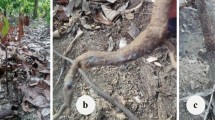Abstract
Lettuce plants in several fields in south-eastern Queensland were affected by a black root rot resulting in slow growth, small head size and harvest reductions. Isolation and pathogenicity tests showed Chalara elegans was the causal fungus. The host range included bean and cucurbits but not capsicum, celery, cotton, eggplant, parsley, radish or tomato. The weed Sonchus oleraceus was a natural host. Lettuce cultivars ranged in susceptibility with Centenary, Kirralee and Monaro being tolerant and Classic, Yatesdale and Buffalo being susceptible. The fungicides benomyl and propiconazole were inhibitory to growth of C. elegans in culture, while root drench applications controlled the disease in a glasshouse experiment.
Similar content being viewed by others
References
Allen, S.J. (1990) — Thielaviopsis basicola, a new record on cotton in Australia. Australasian Plant Pathology 19: 24–25.
Fan, D.F., Bills, G.F., Chamuris, G.P. and Rossman, A.Y. (1989) — Fungi on Plants and Plant Products in the United States. American Phytopathological Society Press, St Paul, Minnesota.
Graham, J.H. and Timmer, N.H. (1991) — Peat-based media as a source of Thielaviopsis basicola causing black root rot on citrus seedlings. Plant Disease 75: 1246–1249.
Hoff, J.K. and Newhall, A.G. (1960) — Corky root rot of iceberg lettuce on the mucklands of New York. Plant Disease Reporter 44: 333–339.
Klimova, A.P. and Koshkelova, E.N. (1981) — Specialization of Thielaviopsis basicola (B, and Br.) Ferraris isolated from weed plants. Izvestiya Akademii Nauk Turkrnenskoi SSR, Biologicheskikh Nauk 5: 65–69. (Abstract in Review of Plant Pathology 61: 346).
Miles, M.R. and Wilcoxin, R.D. (1984) — Production of fungal inoculum using a substrate of perlite, cornmeal, and potato-dextrose agar. Plant Disease 68: 310.
Nag Raj, T.R. and Kendrick, B. (1975) — A Monograph of Chalara and Allied Genera. Wilfrid Laurier University Press, Waterloo, Ontario, Canada
Prinsloo, G.C., De Villiers, D.A. and De Bruin, D.J. (1989) — Activity of triadimenol and flusilazole against Thielaviopsis basicola in tobacco. Phytopkylactica 21: 83–84.
Simrnonds, J.H. (1966) — Host Index ofplant Diseases in Queensland. Queensland Department of Primary Industries, Brisbane.
Stover, R.H. (1950) — The black root rot disease of tobacco. II. Physiologic specialization of Thielaviopsis basicola on Nicotiana tabacum. Canadian Journal of Research 28: 726–738.
Subramanian, C.V. (1968) — Thielaviopsis basicola. C.M.I. Descriptions of Pathogenic Fungi and Bacteria. No. 170. Commonwealth Agricultural Bureaux.
Yanvood, C.E. (1946) — Isolation of Thielaviopsis basicola from soil by means of carrot discs. Mycologia 38: 346–348.
Author information
Authors and Affiliations
Rights and permissions
About this article
Cite this article
O’Brien, R.G., Davis, R.D. Lettuce black root rot — a disease caused by Chalara elegans . Australasian Plant Pathology 23, 106–111 (1994). https://doi.org/10.1071/APP9940106
Received:
Accepted:
Issue Date:
DOI: https://doi.org/10.1071/APP9940106




